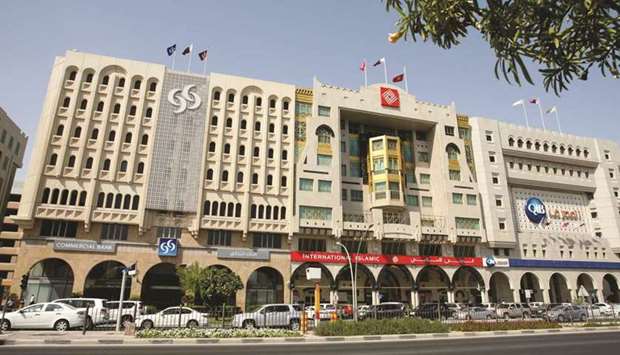Qatari banks continue to exhibit the highest average ROE or return on equity of 11.6% in the first quarter (Q1) of this year, higher than the Gulf average, according to Kamco Invest.
Saudi Arabian lenders had registered an average ROE of 9.2%, followed by UAE banks at 7.2%. On the other hand, Kuwaiti banks reported the lowest average ROE of 4.6%, Kamco said in its sector report.
The ratio remained relatively low at around 8.2% for the GCC banking sector compared to historical levels, although the aggregate ROE for the GCC (Gulf Co-operation Council) banking sector showed marginal improvement for the first time in six quarters.
In the case of operating costs, which have a bearing on in the bottom-line performance; Kamco found that Qatari banks reported the lowest ratio of 31.1%, which also reflected Qatari banking sector’s relatively high loan-to-deposit ratio at 89% at the end of Q1-2021.
The costs remain the highest in the case of Bahraini banks at 61.1% followed by Omani banks at 47.6%. Saudi Arabian banks also reported one of the highest cost-to-income ratios of 46.4% during Q1-2021 TTM (trailing twelve months).
Highlighting that the Covid-19 affects cash dividend payments of 2020; Kamco said the decline in cash dividend payments was seen across the board in the GCC with banks in all the countries slashing dividends.
Nevertheless, Qatari banks witnessed the smallest decline during the year at 25.4% and made payments of $2.1bn; whereas Bahraini banks made the biggest percentage cuts to dividends at 72.4%.
Saudi Arabian banks were the next, slashing cash dividends by 64.1%, while the UAE-listed banks slashed dividends by 36.4%.
The report said loan loss provisions (LLP) in Q1-2021 declined across the board in the GCC banking sector compared to Q4-2020.
Total provisions recorded during Q1-2021 stood at a six-quarter low level of $3.6bn against $6.1bn during Q4-2020. The UAE banks reported the biggest absolute sequential decline in LLP at $0.9Bn to $1.5bn, still the highest in the GCC.
The Qatari banks were next with an LLP of $0.7bn during the quarter, with a quarter-on-quarter decline of $0.3bn, followed by Kuwaiti banks that booked provisions of $0.64bn, registering a quarterly decline of 34.4%.
Stressing that oil prices provide a much need breather for the sector; the report said crude prices have traded comfortably around the $65 a barrel recently, thus lowering the borrowing requirements for GCC governments.
In addition, the prioritisation of government spending programme since the start of the pandemic further lowered the need to raise funds by GCC governments.
According to the International Monetary Fund, the GCC government fiscal deficit is expected to contract from 9.2% in 2020 to 3% in 2021.
"This gives governments in the region the necessary policy space to continue uninterrupted infrastructure spending in the near term and would result in a positive outlook for the banking sector," Kamco said.
Observing that credit growth holds the key for the (banking) sector’s full revival; it said the central bank data on credit facilities grated by GCC banking sector for Q1-2021 showed optimistic data for most of the countries.
Saudi Arabia showed the strongest quarter-on-quarter growth in credit offtake with an increase of 5.4% followed by 4.1% for Qatar and 1% in the case of Kuwait.
Saudi Arabian lenders had registered an average ROE of 9.2%, followed by UAE banks at 7.2%. On the other hand, Kuwaiti banks reported the lowest average ROE of 4.6%, Kamco said in its sector report.
The ratio remained relatively low at around 8.2% for the GCC banking sector compared to historical levels, although the aggregate ROE for the GCC (Gulf Co-operation Council) banking sector showed marginal improvement for the first time in six quarters.
In the case of operating costs, which have a bearing on in the bottom-line performance; Kamco found that Qatari banks reported the lowest ratio of 31.1%, which also reflected Qatari banking sector’s relatively high loan-to-deposit ratio at 89% at the end of Q1-2021.
The costs remain the highest in the case of Bahraini banks at 61.1% followed by Omani banks at 47.6%. Saudi Arabian banks also reported one of the highest cost-to-income ratios of 46.4% during Q1-2021 TTM (trailing twelve months).
Highlighting that the Covid-19 affects cash dividend payments of 2020; Kamco said the decline in cash dividend payments was seen across the board in the GCC with banks in all the countries slashing dividends.
Nevertheless, Qatari banks witnessed the smallest decline during the year at 25.4% and made payments of $2.1bn; whereas Bahraini banks made the biggest percentage cuts to dividends at 72.4%.
Saudi Arabian banks were the next, slashing cash dividends by 64.1%, while the UAE-listed banks slashed dividends by 36.4%.
The report said loan loss provisions (LLP) in Q1-2021 declined across the board in the GCC banking sector compared to Q4-2020.
Total provisions recorded during Q1-2021 stood at a six-quarter low level of $3.6bn against $6.1bn during Q4-2020. The UAE banks reported the biggest absolute sequential decline in LLP at $0.9Bn to $1.5bn, still the highest in the GCC.
The Qatari banks were next with an LLP of $0.7bn during the quarter, with a quarter-on-quarter decline of $0.3bn, followed by Kuwaiti banks that booked provisions of $0.64bn, registering a quarterly decline of 34.4%.
Stressing that oil prices provide a much need breather for the sector; the report said crude prices have traded comfortably around the $65 a barrel recently, thus lowering the borrowing requirements for GCC governments.
In addition, the prioritisation of government spending programme since the start of the pandemic further lowered the need to raise funds by GCC governments.
According to the International Monetary Fund, the GCC government fiscal deficit is expected to contract from 9.2% in 2020 to 3% in 2021.
"This gives governments in the region the necessary policy space to continue uninterrupted infrastructure spending in the near term and would result in a positive outlook for the banking sector," Kamco said.
Observing that credit growth holds the key for the (banking) sector’s full revival; it said the central bank data on credit facilities grated by GCC banking sector for Q1-2021 showed optimistic data for most of the countries.
Saudi Arabia showed the strongest quarter-on-quarter growth in credit offtake with an increase of 5.4% followed by 4.1% for Qatar and 1% in the case of Kuwait.




